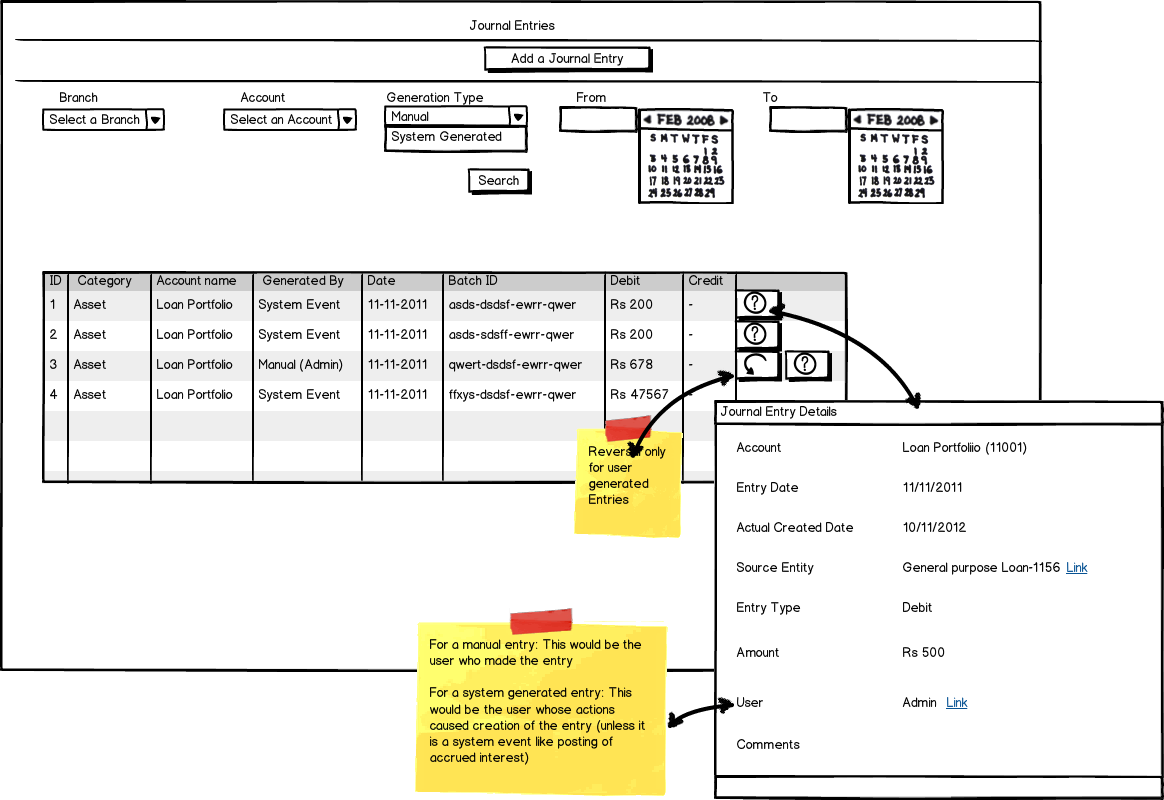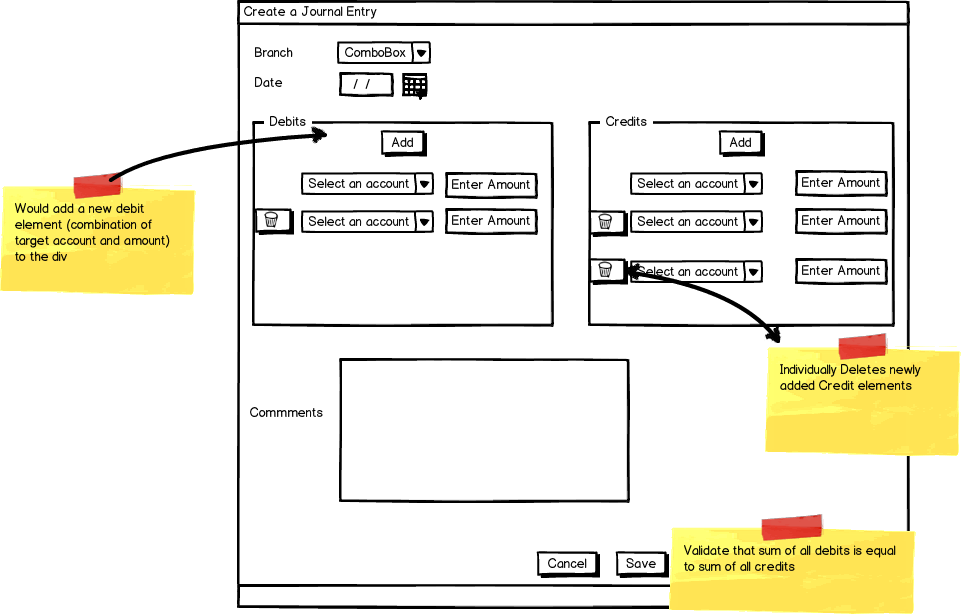...
User must be able to select the applicable accounting rule as "none", "cash" or "accrual" at a product level.
The user is expected at the time of product definition to select the “type” of accounting for the product and select his appropriate General Ledger (GL) “Detail account” for the placeholders MifosX Mifos X accounting module provides
...
Continue having the same design with five main account "Types":
- Assets
- Liabilities
- Income
- Expenditure
- Equity
...
- So system should associate all journal entries to branch which owns the entity that caused the entry (ExExample: Loan account on which a disbursal occuredoccurred)
- all user defined journal entries should also be associated with a branch
...
The 'accounting cycle' image provided on page 22 of attached accounting summary document provides a good visualisation visualization of steps involved from 'economic activity step (transaction)' to closing books for a given cycle period (weekly/monthly/quarterly/yearly)
...
The Journal entries view would look similar to the below mockupmock up
3.1 Automated Journal Entries
MifosX Mifos X to automatically log (log each transaction as a separate journal entry....no need of daily consolidation etc.)
...
They should link back to the entity that generated them (the loan Transaction etc so that a user can analyse the same).
They may only be altered with events generating from the system (ExExample: a user reverts a loan disbursal etc.)
...
For a manual entry, allow "m" debit and "n" credit entries for a "Journal Entry entered by a user" as long as the sums of all debits and credits match.
Allow journal entry reversal (system automatically logs reversal entries of corresponding debits and credits).
This means each journal entry batch must have a batch Id (so all individual entries under it can be identified for easy reversal).
4 Accounting rules for Loans
...
Would only involve posting to three new accounts (Receivables "incomeTypeincome Type") .
4.2.1 COA Snippet
HEAD | Placeholder |
Assets
| Cash |
Loan Portfolio | |
Receivables Interest | |
Receivables Fees | |
Receivables Penalties | |
INCOME
| Interest on loans |
Income from fees | |
Income from Penalties | |
Expenses | Losses Written Off |
...
The entire interest (for complete duration of the loan) is recognized immediately after disbursal.
There are quite a few conflicting views on if this special treatment is required. However, leaving it in here for now till we get feedback from a few accountants.
The sample loan shown here follows a monthly repayment cycle.
Event | Debit | Credit |
Disbursal (7-10-2012) | Portfolio Control Account (1) | Fund (1) |
Interest Receivable (2) | Income from interest (2) | |
Apply Fee (7-10-2012) | Fees Receivable(3) | Income from fees (3) |
Principal, Interest and Fee Repayment(1) (7-11-2012) |
Fund (4) | Interest Receivable (4) |
Portfolio Control Account (4) | ||
Fees Receivable(4) | ||
Prepayment for next n-1 Instalments Installments (excluding part of last principal) (8-11-2012) |
Fund (5) | Interest Receivable (5) |
Portfolio Control Account(5) | ||
Prepayment of remaining Principal (17-11-2012) | Fund (6) | Portfolio Control Account(6) |
...
Event | Debit | Credit |
Disbursal (7-10-2012) | Portfolio Control Account (1) | Fund (1) |
Automated System Event (when an Interest repayment becomes due) (7-11-2012) | Interest Receivable (2) | Income from interest (2) |
Principal, Interest Repayment(1st Installment) (7-11-2012) | Fund (3) | Interest Receivable (3) |
Portfolio Control Account (3) | ||
Prepayment for remaining Instalment’s Installment’s (no interest accrued) (7-11-2012) | Fund (4)
| Portfolio Control Account(4) |
...
- Real account: Debit what comes in and credit what goes out.
- Personal account: Debit who receives and Credit who gives.
- Nominal account: Debit all expenses & losses and Credit all incomes & and gains
Debit | Credit | |
|---|---|---|
Asset | Increase | Decrease |
Liability | Decrease | Increase |
Equity | Decrease | Increase |
Income | Decrease | Increase |
Expenditure | Increase | Decrease |
...
7.2 Income Statement (P & L statement)
Income Statement Is a company's financial statement that indicates how the revenue (money received from the sale of products and services before expenses are taken out) is transformed into the net income (the result after all revenues and expenses have been accounted for, also known as Net Profit ).
It displays the revenues recognized for a specific period, and the cost and expenses charged against these revenues
...
Table stores the “Chart of Accounts” for an organization.
| Column Name | Data Type | Description |
|---|---|---|
| id | int | |
| gl_code | varchar(45) | |
| category | varchar(45) | Whether the account falls under “asset”, “income”, “expense”, “liability” or “equity” |
| parent_Id | int | References “id” of table “m_acc_coa”. For enabling a hierarchical COA |
| name | varchar(45) | |
| type | varchar(45) | Either “header” or “detail” account. Header accounts will not have transactions logged against them |
| description | varchar(500) | |
| disabled | Boolean | A Flag indicating if the account has been disabled (not deleted). No more manual entries can be posted against a disabled Account |
| manual_entries_allowed | Boolean | Flag indicates if manual Journal entries can be passed against this account |
...
Table stores the “Chart of Accounts” for an organization.
| Column Name | Data Type | Description |
|---|---|---|
| accounting_rule | varchar(45) | The type of accounting required. Either “none”, “cash” or “accrual” *Selecting none would disable posting of all accounting transactions |
...
Table stores all journal entries generated in the system (either created automatically by the system and those created manually).
| Column Name | Data Type | Description |
|---|---|---|
id |
| Primary key for the entry |
| coa_id | int | Foreign key to the Chart of Accounts Table |
entry_date | DATE TIME | The entry date for the journal entry (can be backdated to any date etc) |
batch_id | varchar(45) | Batch key for the entry, could be a UUID generated by Java.Used to link together a set of related Journal entries |
type | varchar(45) | Whether the entry is a debit or a credit |
amount | Float |
|
description | varchar(500) | user notes for manual entries |
branch_id |
| Branch with which this entry is associated |
reversal_id |
| Foreign key to another journal entry which reversed this journal entry (id column of acc_journal_entry) |
is_reversed | Boolean | Flag indicating if the Journal entry is reversed (an entry can be reversed only once) |
entity_type | varchar(45) | “Loan” or “Savings” account for system generated entries. Null for manual entries |
entity_id | int | Nullable foreign key to a loan or savings account |
system_generated | Boolean | Flag indicating whether the entry was logged automatically by the system |
created_date | Date | Audit feild to indicated the actual date on which the entry was posted into the system |
created_by | varchar(45) | Foreign key to user who created the Entry (for manual entries) |
...
Table stores details of all branches and dates for which all Journal entries have been closed.
| Column Name | Data Type | Description |
|---|---|---|
Id | Int |
|
closing_date | DATE |
|
office_id | Int | Id of the office for which the closure date is applicable |
created_by | varchar(45) |
|
created_date | DATE |
|
last_updated_date | DATE |
|
...

